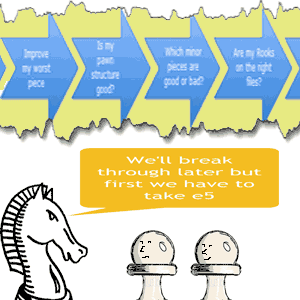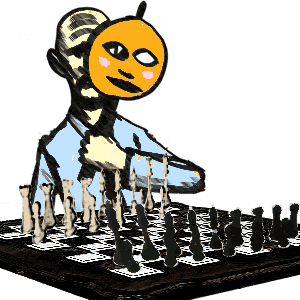Polish Your Positional Chess So It Sparkles

Positional Chess: Think carefully and make sure your moves improve your position
You're going to hear lots about centralization, center control, open files, half-open files, outposts, pawn structure, passed pawns, isolated pawns, doubled pawns, dynamic strengths, static advantages and lots more besides. For now dip your toe in the waters of positional strategy.
Before learning about the technical elements of positional chess you should start thinking along positional lines. Let's make an instinctive reflex, when casting your eye on a position, to identify at will the lay of the land. We want certain things to stand out to you immediately.
Plan Strategically but Think Schematically

Positional Chess: As you build your long-term strategic plan you can achieve secondary goals along the way
You'll be trying to win battles in order to turn the course of the war in your favor. Sometimes it will be a struggle for control of a central square. Or you could be trying to win an isolated pawn. You might be trying to force a breakthrough to invade the enemy camp.
You may find that you engage in a series of short term objectives that contribute to assuming a winning position. Identifying these stepping stones to victory, as part of a broader game plan can be thought of as thinking and acting schematically.
Train Your Eye to Assess the Position

Positional Chess: Does your Bishop and Knight trump his Rook and two pawns? How good are you with material imbalances?
Improving at chess is simply getting better at reading the position. Recognizing the various positional elements, seeing the red flags as soon as they pop up and acting accordingly.
When your opponent plays a move that hurts his position you will see it immediately and pounce. Positional errors make you prone to tactical shots. This is when you lose material or even find yourself getting checkmated.
Play to the Pawn Structure
Positional Chess: (Kings Indian Defense, Petrosian System) - White has a space advantage on the Queenside and will play on this wing. Black has a space advantage on the Kingside and will attack there.
If they point towards the Queenside then you will attack on this wing. Some openings lead to a struggle for control of a particular file. There are openings that are so well analyzed, they have lines 15 to 20 moves in depth that lead to a fight over a particular pawn or square. The entire opening hinges on winning this particular battle which will be decisive in terms of the overall outcome.
When you study openings you will be learning what middlegame plans and motifs they lead to. What elements will be found and how to play them. The nature of these middlegame tussles will be laid out in detail. The opening governs the kind of middlegame you will play.
Only Attack with the Initiative
Positional Chess: (Triple-Muzio Gambit) - White has sacrificed two pieces for a ferocious attack on the King. He must attack and win before the Black pieces come into the game. Black must play for his immediate survival, if he weathers the storm he can think of attack later but not now.
You have to create the conditions for a successful attack on the King before entertaining any notions about going after him. If you attack and your opponent withstands the attack, you're in trouble. You will likely have made positional compromises and maybe gave up material.
When your attack peters out you often find yourself facing a grim fight to survive. It could be a quick counter-attack against your deserted King or a longer drawn out squeeze against his stronghold. Make sure you have the material advantage in the vicinity of your opponent's King to win the game before you attack.
Moving On

Positional Chess: Can you hide your real intentions and spring a surprise tactical combination
You don't have to reinvent the wheel. All modern opening theory is designed not just with opening goals like development and King safety in mind. Each opening also has the approach to the middlegame in mind. Entire plans and strategies built in.
Positional awareness is important but the complete chess player has other strings to his or her bow. The icing on the positional cake. Time to improve your tactics.






